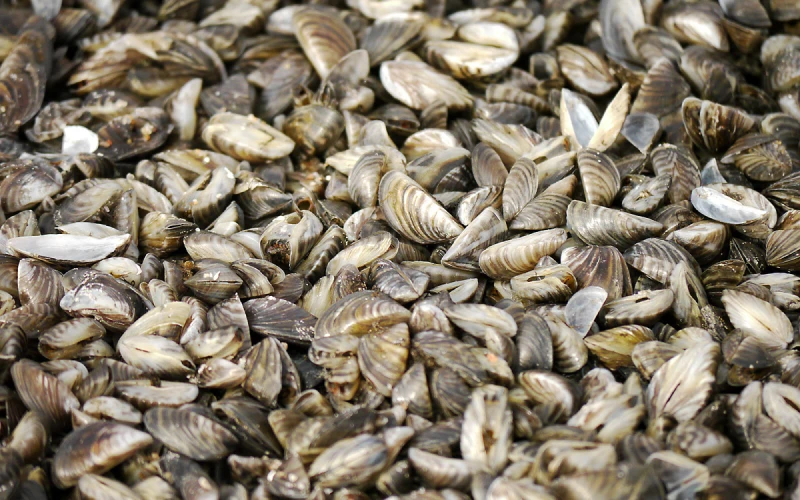Zebra Mussel
Description
Zebra Mussels are small, freshwater mollusks identifiable by their distinctive black, brown, and white zigzag patterns. While they bear a resemblance to Quagga Mussels (another invasive mussel to Canada), Zebra Mussels are smaller, more square, and have a narrower body.

Zebra Mussel © Peter Taylor, some rights reserved (CC BY-NC)
Introduction and Spread
Native to the Black and Caspian Seas region of southeastern Europe, Zebra Mussels were first introduced to North America through ballast water discharged from ships in the late 1980s. They have since spread across eastern Canada and the United States, largely due to their ability to attach to watercraft and survive out of water for up to 18 days under humid conditions [1]. This trait allows them to be easily transported over land to new water bodies.
Distribution
Zebra Mussels have been found in several major water systems across North America, including Lake St. Clair, the Great Lakes, the St. Lawrence River, the Mississippi River watershed, Lake Winnipeg, Red River, Nelson River, and the Saint John (Wolastoq) River watershed. As of 2024, Fisheries and Oceans Canada have reported that zebra mussels have expanded into New Brunswick waters as far east as Mactaquac, near Fredericton, in the Wolastoq (Saint John) River.
Habitat
Zebra mussels thrive in freshwater environments and are incapable of surviving in marine conditions. They spread through natural water currents as larvae and can attach to any solid surface in the water [2]. Important dispersal mechanisms include attachment to watercraft and floating in ballast water, which necessitates the Clean, Drain, Dry protocol for water users moving between water bodies.
Identification
Impacts
Zebra Mussels create significant ecological and socio-economic challenges. Ecologically, they disrupt food webs by outcompeting native mussels and filtering the water of substrates. Clearer water increases the growth of aquatic vegetation and can cause toxic algal blooms [3]. They are particularly harmful to native mussel species, many of which are at risk of suffocation when Zebra Mussels attach to them. Economically, they cause extensive damage to water infrastructure and watercraft by clogging intake structures, resulting in millions of dollars in annual damage in Canada.
Management Actions
Prevention and management of Zebra Mussel spread include:
What You Can Do:
Observations and Reporting:
The public is encouraged to report sightings of Zebra Mussels to help with early detection and management efforts. Reports can guide the implementation of rapid response strategies to contain and mitigate the spread of this invasive species.
CLEAN DRAIN DRY:
Additional Information
Resources:
1. Vanderbush, Brandon & Longhenry, Chris & Lucchesi, David & Barnes, Michael. (2021). A Review of Zebra Mussel Biology, Distribution, Aquatic Ecosystem Impacts, and Control with Specific Emphasis on South Dakota, USA. Open Journal of Ecology. 11. 163-182. 10.4236/oje.2021.112014.
2. Czerniawski, Robert, and Tomasz Krepski. “Does lake eutrophication support biological invasions in rivers? A study on Dreissena polymorpha (Bivalvia) in lake-river ecotones.” Ecology and evolution vol. 11,18 12686-12696. 13 Aug. 2021, doi:10.1002/ece3.8013
3. Czerniawski, Robert, and Józef Domagała. “Reduction of zooplankton communities in small lake outlets in relation to abiotic and biotic factors.” Oceanological and Hydrobiological Studies 42 (2013): 123-131.